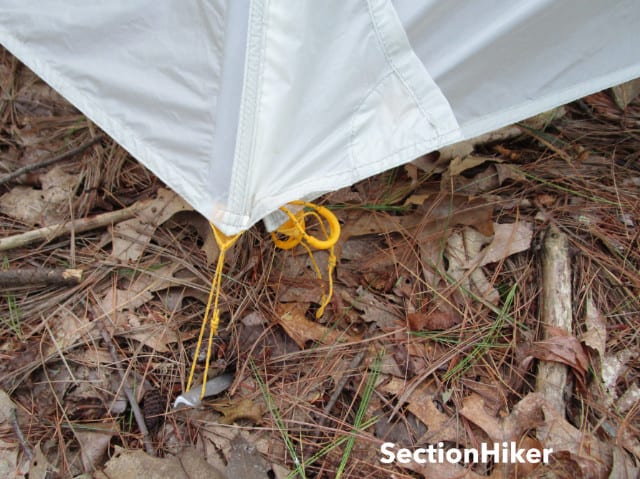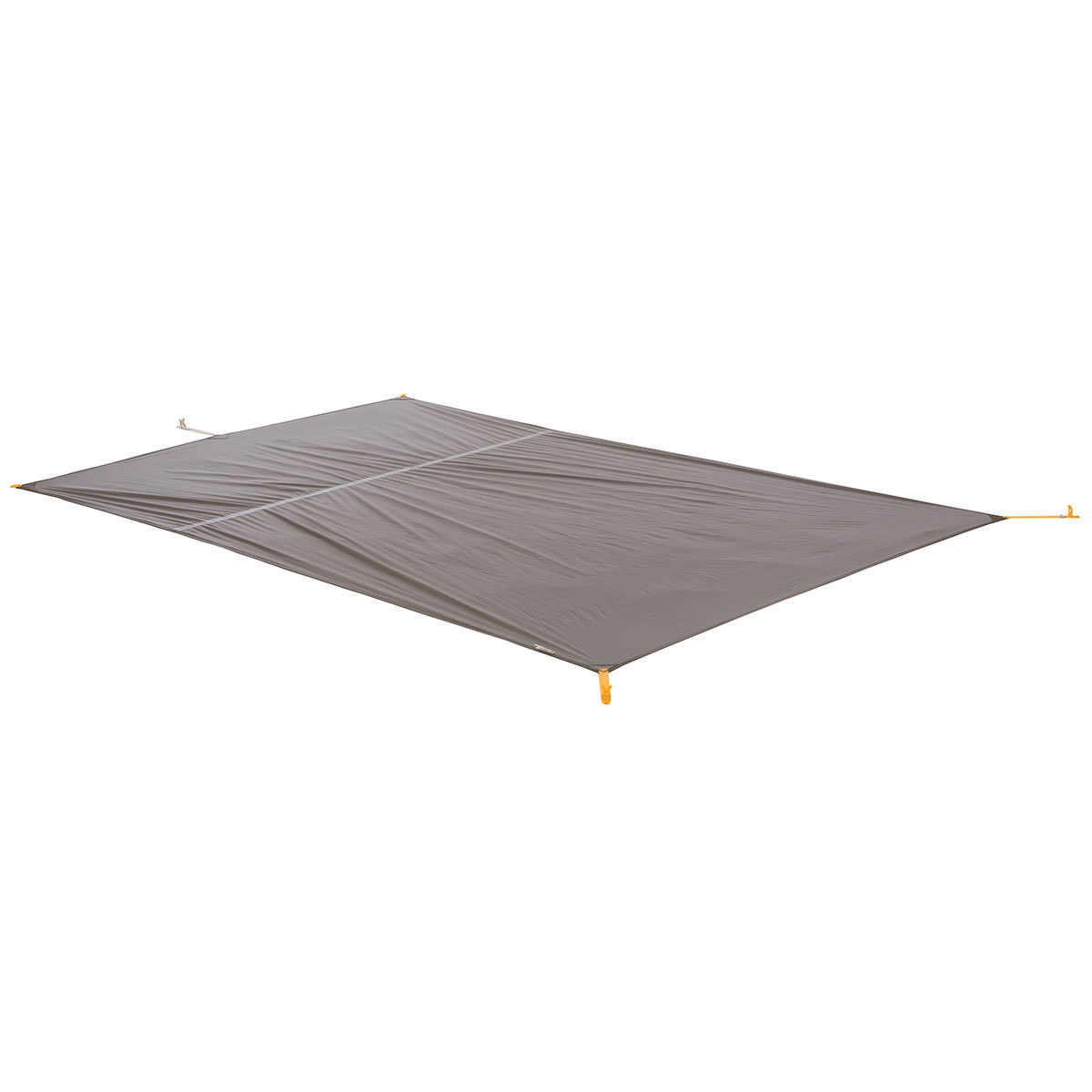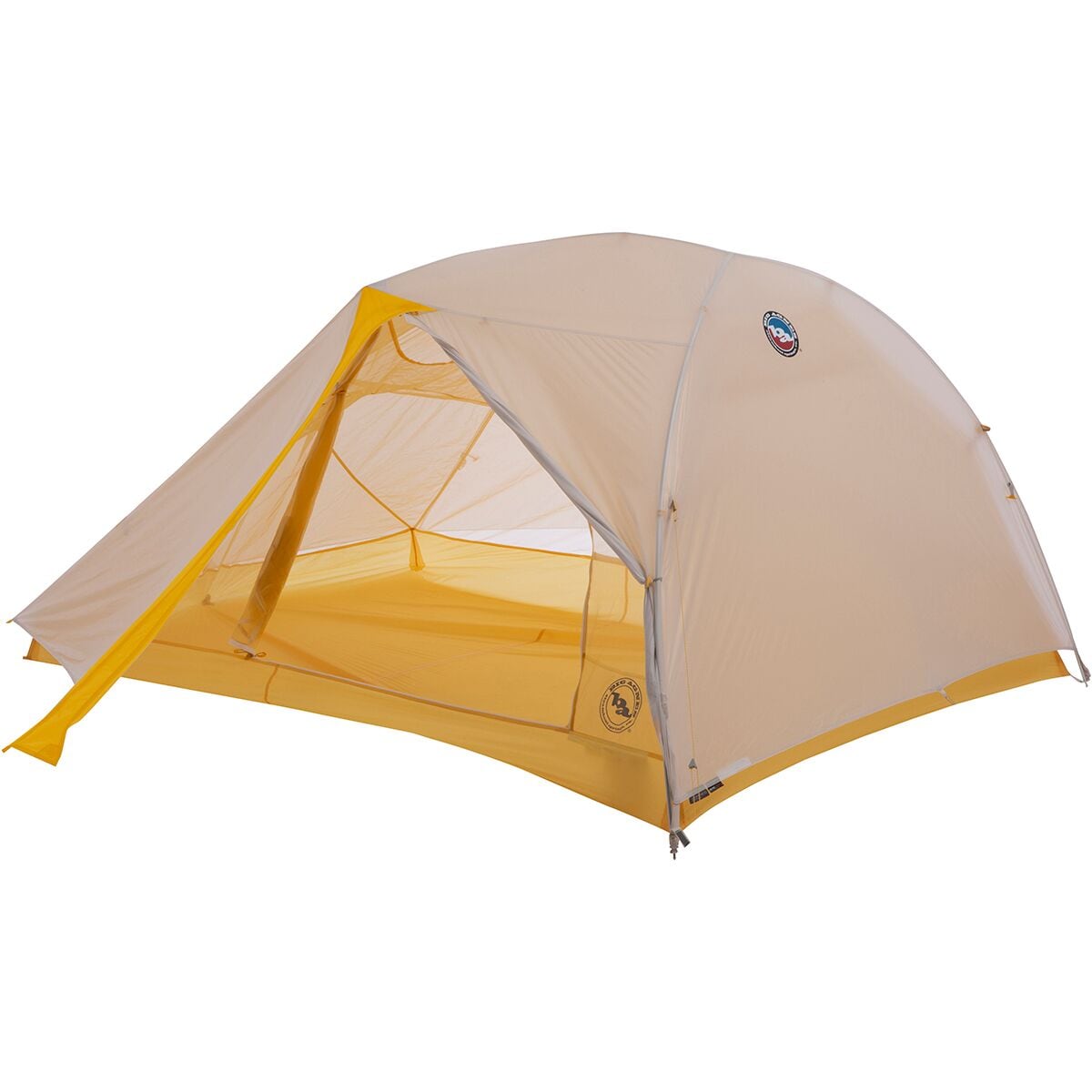The Big Agnes Tiger Wall UL3 is a lightweight two-door, two-vestibule, three-person tent that only weighs 2 lbs 10 oz. While it is large enough to fit three people, if you don’t mind crawling over one of your tent partners to get in and out, it’s lightweight enough to use as a spacious two-person backpacking tent which is the purpose we had in mind when my husband and I bought it. The Tiger Wall UL3 has a hub pole design that makes it super easy to set up and provides near-vertical sidewalls with ample head and foot room. The lightweight mesh inner tent provides excellent ventilation while the rainfly has dual zippers and rain flaps on the doors so you can still ventilate the tent even when it rains.
Big Agnes Tiger Wall UL3 Tent
Comfort
Ease of Setup
Weather Resistance
Durabilty
Weight
Packed Size
Spacious and Lightweight
Specs at a Glance
- Capacity: 3 people
- Doors: 2
- Vestibules: 2
- Type: Double wall, semi-freestanding
- Weight:
- Minimum trail weight: 2 lbs, 10 oz
- Packed weight: 2 lbs 15 oz
- Fast fly weight (without inner): 2 lbs 2 oz
- Floor area: 38 sq ft
- Head height: 42”
- Length: 88″
- Width: 66″ (head), 60″ (foot)
- Materials
- Fly material: fly (15d) and floor (20d) are silicone-treated ripstop nylon with 1200 mm waterproof polyurethane coating
- Tent body: breathable nylon and polyester mesh
- Poles: DAC Featherlite pole system
- Included: tent pole repair sleeve, extra guyline, stakes, stuff sack & bags for poles, and 8 stakes.
Tent Design and Materials
The Tiger Wall UL 3 is a double-wall semi-freestanding tent with an inner mesh tent that is suspended from a three-pronged overhead dome-shaped pole-structure. While the corners of the foot end still need to be staked out for maximum livability, setting up a tent like this is very easy since it won’t fall over before you can get your tent stakes in. The rainfly simply drapes over the dome-shaped pole structure, so air can circulate between the inner and outer tent. The only downside is that the interior can get wet if it’s raining when you erect the inner tent, but carrying a small trail towel is sufficient to mop up any rain that gets through.

The Tiger Wall poles are DAC Featherlite aluminum with a shock-corded hub at the tent’s head end. There is a cross piece that is also attached to the pole system with a swivel. The poles go into 2 grommets at the head end and 1 at the foot. The inner tent has clips to attach it to the poles. The cross pole connects to the tent body above the doors and helps to create vertical sidewalls. The fly goes over the poles and clips to the body at the pole points where webbing can be tightened with ladder lock clips. There are also hook and loop straps to help line up the fly on the poles properly and lock down the structure if its windy.

The Tiger Wall has 2 side vestibules that provide plenty of room for external but covered gear storage. The side doors have two zippers each, which means you can crack open the top of the fly doors along the top (like a transom) if you want more airflow inside the tent while keeping the bottom half of the door closed for more privacy or warmth. The zippers have a rain flap covering them, which helps prevent rain from dripping into the tent when the doors are cracked open. I forgot to close the zipper one rainy night and no rain dripped inside and they work well.

However, the rainfly is made with a very thin 15 denier fabric that can get caught in the zipper if you’re not careful to support it with two hands when opening or closing it. As a frequent lightweight backpacker, I’m used to dealing with lighter weight fabrics, but my husband isn’t and managed to snag the zippers repeatedly. Undoing the snags isn’t difficult because the fly fabric is slippery, but you need to be careful when doing it so you don’t rip the fly.

The inner tent has an abundant amount of insect-proof mesh which provides great airflow, with solid panels for added privacy. The doors have two zippers that make getting in and out or handing items through the doors without having to open them up entirely, which you want to avoid when mosquitos are about. There are also side pockets at the head end for storing personal items, a loft-style media pocket, along with gear loops for hanging items overhead.
The floor is made with 20 denier fabric and given how light the fabric is, I’d recommend using the tent with a footprint. Big Agnes sells a Tiger Wall UL3 footprint, but I use a much less expensive piece of Tyvek. SectionHiker also recommends window insulation wrap for this purpose, which is even lighter weight but less durable.

While the Tiger Wall UL3 is a bomber dry in rain, the factory guylines on the rainfly are quite short and fixed length. This can result in some moisture transfer from the rainfly to the foot-end of the inner tent after some rain, since the inner tent and fly hook into the same tent stake. The short lines also leave little flexibility when trying to find a place where you can stick a stake in easily and solidly. I plan to replace the fixed-length guylines on the rainfly with longer cord and line loc adjusters to create a bigger gap between the inner tent and fly to prevent moisture transfer while making it easier to find good stakeout points.
Livability
I found the Tiger Wall UL3 to have plenty of headroom with 42” of vertical space at the head end. I had almost 10” of extra headspace at the highest point. The side walls are vertical which helps improve the available space inside. The width of the floor at the head end is 66” and the width at the foot is 60”. This means you can just squeeze in three regular (20″) mummy-shaped sleeping mats, but three wider (25″) mats won’t fit. A third center person will also need to climb over a tent mate in order to exit the tent while it is fully occupied, which is probably ok if it’s a small child or a dog, but a hassle otherwise.

Our preference is to use the Tiger Wall UL 3 as a two-person tent, where you have ample space and each occupant gets their own vestibule. While the Tiger Wall UL 3 is 8 oz heavier than the Tiger Wall UL 2, this is a space-to-weight tradeoff that we’re willing to make. The larger Tiger Wall UL 3 is still well under 3 lbs in weight, which is pretty incredible for a three-person backpacking tent. If you shop around, you’ll find very few three-person tents that are designed for backpacking that weigh less.

Packing
The poles and stakes have their own stuff sacks and there is a stuff sack large enough to hold all the tent components if you choose to pack that way. If you are dividing with a partner, then you can easily keep the metal parts separate. I seldom use the stuff sacks that come with my tents. Normally I just squash the tent body and fly into the bottom of my pack so that it takes up the space better than a round tent bag. Don’t forget….always stuff your tents rather than trying to fold them. Not only does folding the same way repeatedly create stress points, but it’s also a pain in the neck to do outside in the dirt.
Comparable 3 person backpacking tents
There are very few lightweight three-person tents that come close to the Tiger Wall UL3 in weight and price.
| Make / Model | People | Doors | Weight | Price |
|---|---|---|---|---|
| Big Agnes Tiger Wall UL3 | 3 | 2 | 42 oz | $499 |
| Big Agnes Copper Spur HV UL 3 | 3 | 2 | 56 oz | $499 |
| MSR Carbon Reflex 3 | 3 | 2 | 42 oz | $650 |
| NEMO Dagger 3P | 3 | 2 | 60 oz | $530 |
| Zpacks Triplex | 3 | 2 | 21.9 oz | $699 |
| Tarptent Cloudburst 3 | 3 | 2 | 54 oz | $385 |
Recommendation
At 2 lbs 10 oz, the Big Agnes Tiger Wall UL3 is a great tent for a weight-conscious pair of backpackers. Grab a buddy or your honey and split it between you. I got this tent with the intention of using it for 2 people, and it works great for that. You each get enough space so that your cohabitant is not snoring right in your face and you don’t have to share your vestibule. While the Tiger Wall UL3 is a solid poor weather performer in my experience, it not as strong or durable as heavier tents made with thicker fabrics, bulkier zippers, or additional tent poles. That’s frequently the tradeoff you need to make when purchasing an ultralight tent or shelter. As long as you understand the need to use and maintain the tent with due care, you’ll find that the Tiger Wall UL3 provides an impressive amount of luxury and convenience in a small and light package.
Disclosure: The author purchased this tent with her own funds.
Compare 4 Prices
-
 REI$80.00View
REI$80.00View -

 Eastern Mountain Sports$80.00View
Eastern Mountain Sports$80.00View -

 Amazon US$499.95View
Amazon US$499.95ViewAmazon.com Price: $499.95 (as of 04/19/2024 09:17 GMT-0400) Details
Product prices and availability are accurate as of the date/time indicated and are subject to change. Any price and availability information displayed on Amazon.com at the time of purchase will apply to the purchase of this product.
-

 Backcountry.com$499.95View
Backcountry.com$499.95View
 SectionHiker.com Backpacking Gear Reviews and FAQs
SectionHiker.com Backpacking Gear Reviews and FAQs 

Thanks for the great review. I love my Tiger Wall UL3 for many of the same reasons. Excellent headroom. Excellent weight. This is my go-to shelter when I am backpacking with my kids (ages 5 through 11). It comfortably sleeps one adult and two kids. More than enough room for two adults without feeling like you’re on top of one another. All for less than three pounds all-in, including stakes and polycryo footprint.
I think there’s a way to set up the fly with the footprint and without the tent. If no, not only would the be good for warm nights, you could subsequently set up the tent in the rain without getting wet because you’re doing the work under the fly.
Yes, BA lists the Fast Fly weight as 2lbs 2oz. However, you would need to either buy their ground cloth or fabricate something on your own that could hold the poles down and in place. I’m not sure how easy it would be to set up under the fly in the rain. It would probably take a little practice.
In a extremely heavy volume wet snowstorm at 12,200 a few weeks ago, I put up the fly of my Tiger Wall 2P without the body, using the footprint to hold the pole ends. It does work, but even on that basis the footprint had quite a bit of slush before the fly could be completely staked out. I’m not sure any tent wouldn’t have a problem, other than my single wall mountaineering tent. All that said I have had 12 trips over the Summer and really love the Tiger Wall.
” The larger Tiger Wall UL 3 is still well under 3 lbs in weight, which is pretty incredible for a three-person backpacking tent. If you shop around, you’ll find very few three-person tents that are designed for backpacking and not car camping or that weigh substantially more.”
I think there is a typo in here somewhere. Second sentence seems to contradict the first. Are you saying that the tent is heavy or light?
Simplified and clarified.
Does the advice of never folding tents but rather stuffing them apply to dyneema tents. I recently purchased a Double Rainbow Lithium and the packaging recommends folding loosely into pack rather than stuffing it in the pack??
Do what Tarptent says. One of the downsides of Dyneema is the room it takes up.
Yea I had no issues but was just curious, it took up less room as compared to other tents
The footprint has stake loops and is far more likely to stay in place if you’re out of the tent and a wind comes up. I once lost a Tyvek footprint in the Sierras when we were day hiking. I found it caught on a lonely tree about 100 yards away,
Love mine! Put in my pack and don’t even know it’s there. Small and light weight. I don’t know about 3 adults. Sleeps 2 adults perfectly. I have other 3 man tents which seem to be much larger, but much heavier. It has very delicate material and must be treated with a light touch. Awesome tent.